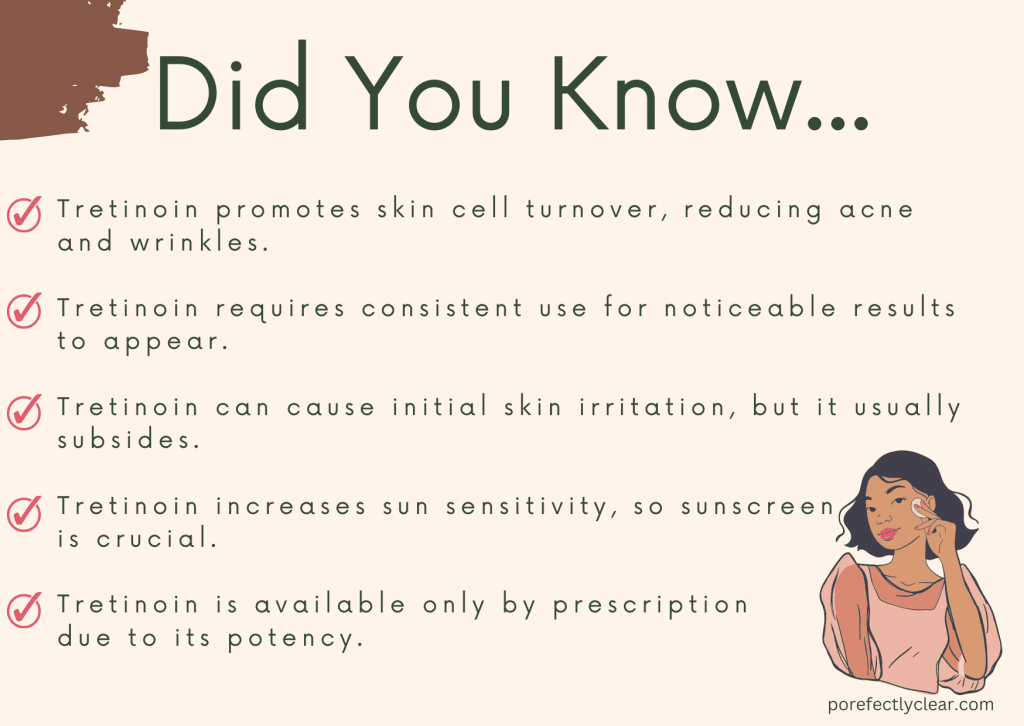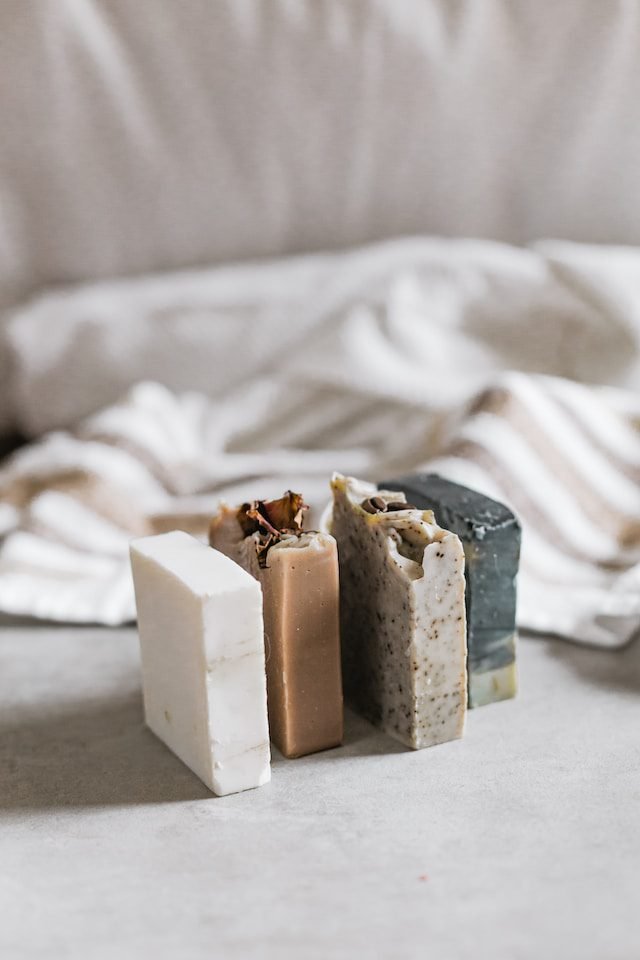If you’re looking to reduce the appearance of wrinkles and fine lines, you may have heard about tretinoin. Tretinoin is a prescription-strength retinoid that can help smooth out your skin and improve its texture. However, with several strengths available, it can be challenging to determine which one is best for your skin.
The best tretinoin strength for wrinkles depends on an individual’s skin needs. Tretinoin usually comes in 3 strengths: 0.025%, 0.05%, and 0.1%. The required tretinoin strength will depend on an individual’s skin needs. Therefore, it is best to consult with a dermatologist to determine the appropriate tretinoin strength for wrinkles.
The strength you need will depend on your skin’s needs and the severity of your wrinkles. While the higher strengths may seem like a better option, they can also come with more side effects.
Key Takeaways
- Tretinoin is a prescription-strength retinoid that can help reduce wrinkles and fine lines.
- Tretinoin comes in three strengths: 0.025%, 0.05%, and 0.1%.
- The strength you need will depend on your skin’s needs and the severity of your wrinkles. Consult with a healthcare provider before using tretinoin to determine the best strength for you.
Tretinoin for Wrinkles and Fine Lines
If you are looking to reduce the appearance of wrinkles and fine lines, tretinoin may be a viable option for you. Tretinoin is a topical medication that belongs to a class of drugs called retinoids. Retinoids are known to increase collagen production and improve skin elasticity, which can help reduce the appearance of wrinkles and fine lines.
Tretinoin works by speeding up the skin’s cellular turnover process, allowing your skin to create new cells and repair itself at a faster rate. This process helps to reduce the appearance of fine wrinkles and fine lines, as well as improve skin texture and tone.
When using tretinoin for wrinkles, it is important to start with low strength and gradually increase the strength as your skin adjusts. Most anti-aging studies show that the best results usually come from moderate-strength tretinoin creams, such as those that contain 0.05% tretinoin. However, if you have more severe signs of aging, your healthcare provider may prescribe a higher-strength tretinoin cream.
It is important to note that using tretinoin for wrinkles requires patience and consistency. It may take several weeks or even months to see noticeable results, and you may experience some initial side effects such as dryness, redness, and peeling. However, with regular use and proper skincare, tretinoin can be an effective anti-aging treatment.
In addition to using tretinoin, it is important to practice good skincare habits to prevent further skin aging. This includes protecting your skin from the sun, staying hydrated, and maintaining a healthy diet rich in protein and antioxidants. By combining tretinoin with a healthy lifestyle, you can achieve a more youthful and vibrant complexion.

Strengths of Tretinoin
Tretinoin is a prescription-strength retinoid that is commonly used for treating acne, dark spots, and wrinkles. It is available in various strengths, ranging from 0.01% to 0.1%. The strength of tretinoin that is best for wrinkles depends on your skin’s needs and the severity of your wrinkles.
The mildest strength of tretinoin is 0.025%, which is usually used for general skin improvements or mild acne. This strength is also suitable for those who have sensitive skin. If you have deep wrinkles or more severe signs of aging, a higher strength may be necessary.
The most common strength used for anti-aging preparations is 0.05%. This strength is effective in reducing the appearance of fine lines and wrinkles. It is also a good starting point for those who are new to tretinoin and want to see how their skin reacts to the medication.
The highest strength of tretinoin available is 0.1%. This strength has the most intense side effects but is often used for severe acne. It is not recommended for those who have sensitive skin or are new to tretinoin.
It is important to note that all percentages of tretinoin require a healthcare provider’s prescription. The required strength of tretinoin will depend on your skin’s needs, and it is best to consult with your dermatologist to determine the appropriate strength for your skin.
Tretinoin Formulations
When it comes to tretinoin for wrinkles, there are several formulations available in the market. The most popular formulations include tretinoin cream, gel, and lotion.
Tretinoin cream is the most common formulation used for wrinkles. It comes in various strengths, including 0.025%, 0.05%, and 0.1%. The strength you should use will depend on your skin’s needs and sensitivity. It is recommended to start with the lowest strength and gradually increase it over time if necessary.
Tretinoin gel is another popular formulation. It is often preferred by people with oily skin because it is less greasy than cream. It also absorbs quickly into the skin, making it an excellent option for those who are always on the go. Tretinoin gel comes in different strengths, including 0.01%, 0.025%, and 0.05%.
Tretinoin lotion is a less commonly used formulation. It is often prescribed for people with sensitive skin or those who experience dryness or irritation from other formulations.
In addition to these formulations, there are also several topical tretinoin combinations available in the market, such as Retin-A Micro, Ziana, Tri-Luma, Renova, Avita, Atralin, Altreno, and Twyneo. These formulations combine tretinoin with other active ingredients, such as antibiotics or hydroquinone, to treat various skin conditions, including acne, hyperpigmentation, and wrinkles.
It is essential to note that tretinoin formulations can cause side effects, such as dryness, redness, and peeling. It is crucial to follow your healthcare provider’s recommendations and use the formulation that is best suited for your skin type and needs.
Skin Care with Tretinoin
Tretinoin is a powerful ingredient that can help reduce the appearance of wrinkles and other signs of aging. However, it can also be harsh on the skin, so it’s important to use it correctly and in conjunction with other skincare products.
When using tretinoin, it’s important to start with low strength and work your way up gradually. This will help your skin adjust to the medication and minimize the risk of irritation. You should choose a strength based on your skin’s needs and your dermatologist’s recommendations.
In addition to using tretinoin, it’s important to take good care of your skin in other ways. This includes using a gentle cleanser to wash your face twice a day, moisturizing your skin regularly to prevent dryness and irritation, and using sunscreen with an SPF of at least 30 to protect your skin from sun damage.
If you have sensitive skin, it’s especially important to be careful when using tretinoin. You may need to start with an even lower strength or use it less frequently to avoid irritation. You should also avoid using other harsh skin care products, such as exfoliants or alcohol-based toners while using tretinoin.
When applying tretinoin, use a pea-sized amount and apply it evenly to your face. Avoid getting it too close to your eyes, mouth, or nose. You should also wait at least 20 minutes after washing your face before applying tretinoin to avoid irritation.
Tretinoin can be a highly effective treatment for wrinkles and other signs of aging, but it’s important to use it correctly and in conjunction with other skin care products to minimize the risk of irritation and maximize its benefits.
Professional Advice on Tretinoin
If you are looking to treat wrinkles with tretinoin, it is important to seek professional advice from a dermatologist. Tretinoin is a prescription-strength retinoid that is used to treat acne, wrinkles, and dark spots.
Your dermatologist can help you determine the right strength of tretinoin for your skin needs. They will consider factors such as your skin type, the severity of your wrinkles, and any other skin issues you may have. They may also recommend other treatments in addition to tretinoin, such as sunscreen and moisturizer, to help protect and nourish your skin.
When using tretinoin, it is important to follow your dermatologist’s instructions carefully. Tretinoin can cause irritation and dryness, especially in the early stages of treatment. Your dermatologist may recommend starting with a lower strength of tretinoin and gradually increasing the strength as your skin adjusts.
It is also important to note that tretinoin is not a placebo and is effective in treating wrinkles and photoaging. Photoaging is the premature aging of the skin caused by exposure to sunlight. Tretinoin has been shown to improve the appearance of photodamaged skin, including photodamaged facial skin.

Frequently Asked Questions
What is the strongest strength of tretinoin cream?
Tretinoin cream is available in various strengths, with the strongest being 0.1%. However, it is important to note that the strongest strength may not always be the best option for everyone. Your dermatologist will determine the appropriate strength based on your skin type, the severity of your wrinkles, and other factors.
When to increase tretinoin strength?
Your dermatologist may recommend increasing the strength of your tretinoin cream if you have been using a lower strength for several months and have not seen significant improvement in your wrinkles. However, it is important to follow your dermatologist’s instructions carefully and avoid increasing the strength too quickly, as this can lead to skin irritation and other side effects.
What percentage of tretinoin is effective for wrinkles?
Tretinoin is effective for wrinkles at concentrations of 0.025%, 0.05%, and 0.1%. However, studies have shown that higher concentrations do not necessarily lead to better results. Using a lower concentration may be just as effective as a higher one, but with fewer side effects.
Is Retin-A 0.05% good for wrinkles?
Retin-A is a brand name for tretinoin cream, and the 0.05% strength is often used for anti-aging purposes. This strength is effective in reducing the appearance of fine lines and wrinkles, but it may not work for everyone. Your dermatologist can help determine if Retin-A 0.05% is the right choice for your skin.
How much tretinoin to use for anti-aging?
The amount of tretinoin cream you should use for anti-aging purposes will depend on your skin type and the strength of the cream. Your dermatologist will provide specific instructions on how much to use and how often to apply it. In general, it is recommended to start with a small amount and gradually increase as your skin becomes accustomed to the cream.





